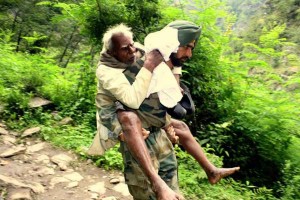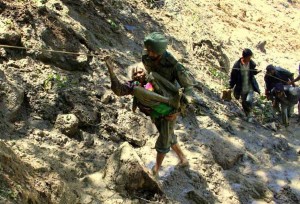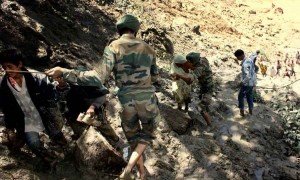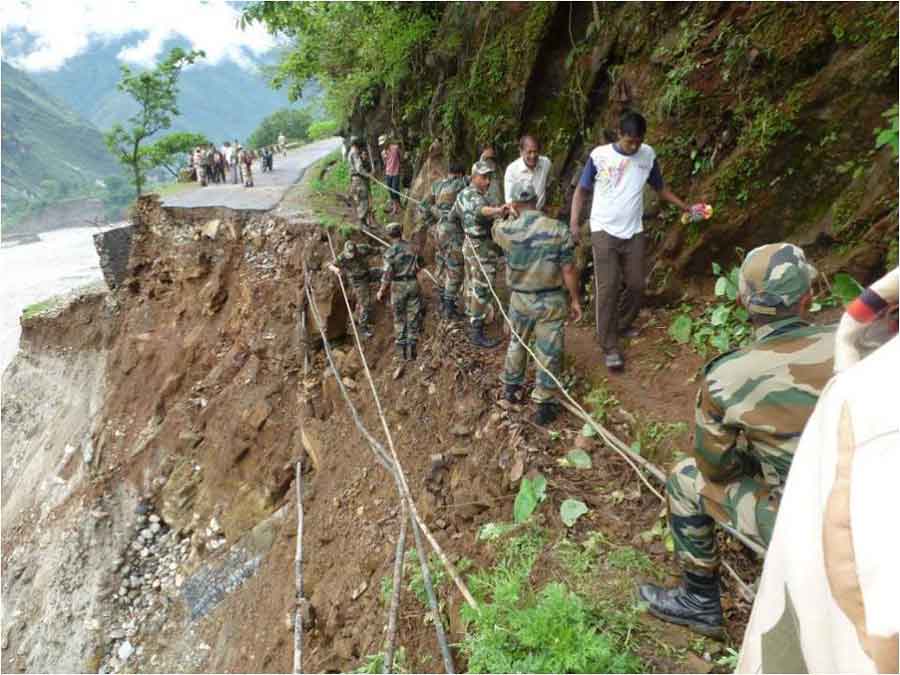The torrential floods in the Himalayas is one of the biggest disaster witnessed in the country over the years leading to over 600 deaths so far since June 15 2013 onwards in Uttrakhand alone. It has once again exposed India’s poor early warning mechanisms, poor disaster mitigation, and rescue and relief response.
Witness how Mumbai was brought to a halt in 2005 or the Leh mudslide in 2010. Lack of early warning mechanisms is apparent, as there were no cautionary notices issues to the locals.
India’s disaster landscape denotes high vulnerability requiring adequate attention to early warning mechanisms, mitigation, capacity building in local, state and central agencies and effective cooperation in application of the same once tragedies like the heavy rain spell in Uttarakhand and Himachal Pradesh denotes. It is time we overcome the siloed approach to emergencies and tackle the same with synergy and a holistic approach.
Some would say that the fatalities and losses be attributed to climatic catastrophe even though extreme weather events such as cloud burst and spells of heavy rains have become the norm in recent years. Witness how Mumbai was brought to a halt in 2005 or the Leh mudslide in 2010. Disaster preparedness and mitigation thus has to cater for these extreme events. Lack of early warning mechanisms is apparent, as there were no cautionary notices issues to the locals.
There are also efforts to ensure that townships and buildings are designed to be disaster proof based on an analysis of the threats faced. There could be no reason otherwise for the crumbling of multi storeyed structures so dramatically seen on television screens. For the unfortunate who were possibly trapped inside these building it was a sad end to life’s dreams. It is time that local authorities and state and district disaster management agencies step in to ensure that norms are followed in buildings for in a multi disaster scenario to which North India is very much suspect the tragedy could be even worse. General insurance companies can also play an important role by denying insurance cover to such structures, which have been built violating all norms. The authorities responsible for sanctioning such unauthorised structures against norms for corrupt practices should be accountable and be severely punished.
The response of the state and central authorities in Uttarakhand also seems to be tardy. While a number of press releases have been issued, the lack of coordination in agencies is apparent with the Ministry of Defence (MoD) and Ministry of Home Affairs (MoH) apparently having launched parallel operations.
 Thus the MoD highlighted that the Indian Air Force (IAF) has launched ‘Operation Rahat’, after IAF assistance was sought for rescue operations. HQ Western Air Command (WAC) promptly responded to the requests from various states for providing flood relief. The IAF, undertook the task simultaneously in the sectors of Yamunanagar, Kedarnath-Badrinath axis, Rudrapyag valley, Karcham-Puh axis.
Thus the MoD highlighted that the Indian Air Force (IAF) has launched ‘Operation Rahat’, after IAF assistance was sought for rescue operations. HQ Western Air Command (WAC) promptly responded to the requests from various states for providing flood relief. The IAF, undertook the task simultaneously in the sectors of Yamunanagar, Kedarnath-Badrinath axis, Rudrapyag valley, Karcham-Puh axis.
Disconnect with the MHA and MoD is more obvious. The MHA has directed Indo-Tibetan Border Police (ITBP) to swing into action and start providing assistance in conjunction with the District Administration to the stranded tourists / pilgrims in Uttarakhand with the response coordinated by IG ITBP. The 14 teams of National Disaster Response Force (NDRF) have also been put into action. The BRO has mobilized its personnel to try and facilitate restoration of road communication across the different routes.
Despite the magnitude of the disaster national response structures such as National Crisis Management Centre (NCMC) or its equivalent have not been put into action.
Despite the magnitude of the disaster national response structures such as National Crisis Management Centre (NCMC) or its equivalent have not been put into action. This would have greatly speeded up response by taking all agencies and ministries on board and effecting better centre state cooperation. Such structures do exist but it appears that these are not being activated when emergencies occur in a single state.
The Army and the Air Force mounted massive rescue and relief operations in the flood and landslide affected areas of Uttrakhand and Himachal Pradesh while the BRO deployed 3000 of its personnel and equipment, working for various projects, to clear the roads and to rescue the stranded people.
The IAF’s C-130J aircraft was launched for reconnaissance mission as a part of ‘Op Rahat’ besides deploying 20 aircraft which include – 08 – Mi-17, 10 – ALH and 01 – An-32 and 01 – Avro to carry out constant missions from first light right up to the last light. While the C-130J on reconnaissance mission flew over – flood affected areas in Dehradun – Uttarkashi, Kedarnath and Joshimath to track the critical areas in the region so as to assign priority to Disaster Relief Operations and facilitate further relief operations, more than 80,00 persons have been evacuated by air and road with the help of IAF, army battalions, NDRF teams and ITBP personnel and dropped more than 20,000 kg of relief material since 16 June with the axis of IAF operations covering– Phata, Guptkashi, Gaurikund, Kedarnath in Dehradun and Rampur, Karcham, Rincompeo, Sangla in Himachal.
 A special task was also carried out by ALH that rescued about 50 marooned villagers in the foothills using winch equipment. This would be subsequently positioned at Pithoragarh sector for rescue and food packet drop effort. Four ALH helicopters of the Sarang Display Team are also deployed for relief operations. One AN-32 aircraft landed at Jolly Grant airfield carrying 10 NDRF personnel and three tonnes of load consisting of tents and other essential items.
A special task was also carried out by ALH that rescued about 50 marooned villagers in the foothills using winch equipment. This would be subsequently positioned at Pithoragarh sector for rescue and food packet drop effort. Four ALH helicopters of the Sarang Display Team are also deployed for relief operations. One AN-32 aircraft landed at Jolly Grant airfield carrying 10 NDRF personnel and three tonnes of load consisting of tents and other essential items.
Soldiers are providing leadership, succour, medical aid and engineer effort.
Army also commenced execution of ‘Operation SURYA HOPE’ with the aim of providing succour, hope, humanitarian assistance and logistic needs in Badrinath, Hemkund and Kedarnath regions. In first phase, Army teams carried out reconnaissance of area and air evacuation of isolated pockets along Govindghat-Badrinath road and Ghagriya-Hemkund track on 19 June and concentrated-isolated people at Badrinath and Ghagriya. Focused air evacuation commenced from both the places from 21 June onwards. In the second phase, Army targeted Kedarnath region. All isolated people have been concentrated at Sonprayag and Kedarnath on June 21 from where the air evacuation commenced till 24 June and held up on 25th June due to poor weather conditions.
In both Badrinath and Kedarnath sectors Army soldiers have been stationed at every 2 Kms all along the roads to enable them to contact isolated people. Soldiers are providing leadership, succour, medical aid and engineer effort. Army has so far inducted 15 medical teams and opened emergency medical helpline. Beside thousands of stranded civilians have been given access to Army communications to facilitate them to contact their families.
The Army so far has inducted 8500 personnel to carryout relief and rescue operations. Army so far evacuated 2016 civilians in Uttarkashi district and provided shelter, food and medical aid to 2300 people. In the Joshimath sector 3034 civilians have been evacuated to Joshimath so far and provided shelter, food and warm clothing to 2276 people. In Kedarnath region, Army has been able to establish contact and distribute food packets to 2250 people at isolated places. As per latest reports, more than 2800 people are still stranded in Harsil – Gangotri area, and approx 5500 in Kedarnath valley, 2500 on Hemkund axis and approx 15,000 on Badrinath axis.
 Army also evacuated 1550 people from Govindghat, inserted four more medical teams on Badrinath and Hemkund axis, distributed more than 5000 food packets in Govingghat, Pandukeshwar, isolated locations in Badrinath and Kedarnath regions. Army doctors treated 300 people in Joshimath, 350 in Harsil, and 170 in Rudraprayag. Army teams repaired mini hydel project in Harsil and power is likely to be restored in the area tomorrow. After clearing 8 land slide sites in the last 2 days, Army cleared road Narendranagar- Uttarkashiupto 40 kms south of Dharasu. Civilian helicopters today evacuated 300 people from Ghagria on Hemkund axis. All of them were provided assistance by the Army.
Army also evacuated 1550 people from Govindghat, inserted four more medical teams on Badrinath and Hemkund axis, distributed more than 5000 food packets in Govingghat, Pandukeshwar, isolated locations in Badrinath and Kedarnath regions. Army doctors treated 300 people in Joshimath, 350 in Harsil, and 170 in Rudraprayag. Army teams repaired mini hydel project in Harsil and power is likely to be restored in the area tomorrow. After clearing 8 land slide sites in the last 2 days, Army cleared road Narendranagar- Uttarkashiupto 40 kms south of Dharasu. Civilian helicopters today evacuated 300 people from Ghagria on Hemkund axis. All of them were provided assistance by the Army.
Unfortunately, the defence forces get the raw deal from the political and bureaucratic leadership. They feel ashamed and demoralised when they see the government fighting a legal battle against them with respect to their genuine pay and allowances…
The BRO has diverted its resources – personnel and equipment for Projects such as Shivalik, Deepak and Hirak for clearing roads and to rescue the affected people. All Bulldozers, JCBs, Excavators, Compressors and other platforms have been deployed for the rescue and restoration work as per the press release.
Indian military has a very strong reputation in disaster management that is possibly now being tested particularly as floods have a longer time span than other disasters and make surface communications difficult. Thus the Air Force in particular has been pressed into service and has been active in rescue and evacuation from the hilly areas in Uttarakhand and Himachal Pradesh where a large number of persons have been stranded.
Indian armed forces are carrying out a yeoman’s service against all odds selflessly, risking their own lives day and night in rescuing the tourists, pilgrims and the locals when the civil administration and any other services have completely failed to do so.
Unfortunately, the defence forces get the raw deal from the political and bureaucratic leadership. They feel ashamed and demoralised when they see the government fighting a legal battle against them with respect to their genuine pay and allowances when the SC has ordered to give their genuine dues to them. It is high time that they be involved in the decision making of the country’s important issues like national security and integrity and disaster management, which are being handled by the bureaucrats, who are clueless about these issues.
Our Armed Forces remain the centrepiece of our national security. They symbolize the nobility of selfless service and sacrifice, and step up to give their lives in order to maintain the independence all Indians enjoy.






The Uttarkhand [ UK] Tragedy was almost entirely man made-The Greedy,overambitous & callous Politicians [Congress & BJP ] & Bureaucrats of Uttarkhand Disregarded all warnings from GSI,CAG, Met.dept.,Environmentalists about the impending Tragedy…They wanted to make Uttarkhand a HYDROELECTRIC & RELIGOUS TOURISM SUPERPOWER !! We Indians have been paranoid about China building a few dams over the Brahmaputra in Tibet as it would affect the water tp Assam & the North-East , But what the UK Govt is doing is much worse & dangerous. By planning the Construction of 70 Plus Dams in UK they may affect the water supply to North India-Haryana,Delhi,UP,Bihar & WB are all going to suffer.The Mining mafia,Construction mafia,Tourism mafia have all created dangers everywhere..For example,3 Star hotels have been allowed over soft River banks,Where even building a hut is dangerous..Ultimately,they paid for their sins of ommission & commission. The Armed Forces once again did a wonderful job in saving & rescuing thousands of Pilgrims & tourists..